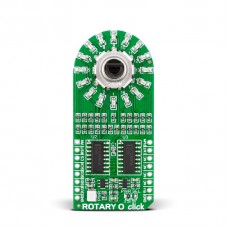ROTARY O click
Rotary click carries a 15-pulse incremental rotary encoder with detents, surrounded by a ring of 16 orange LEDs. It’s a perfect solution for adding a precision input knob to your design. The encoder outputs A and B signals (out of phase to each other); the knob also acts as a push-button which sends an interrupt to the target board MCU. The LED ring is controlled through SPI lines (CS, SCK, MISO, MOSI). Rotary click can be used with either a 3.3V or 5V power supply.
Specification
| Type | Rotary encoder |
| Applications | Wheel controllers that spin infinitely are useful for controlling audio/video equipment and similar appliances |
| On-board modules | 15-pulse incremental rotary encoder, ring of 16 orange LEDs |
| Key Features | 30 indents (dividing the rotation into discrete increments), Pushbutton built in the knob |
| Key Benefits | LED ring for visual feedback |
| Interface | SPI,PWM,Analog,GPIO |
| Input Voltage | 3.3V or 5V |
| Compatibility | mikroBUS |
| Click board size | L (57.15 x 25.4 mm) |
Features and usage notes
Rotary click with its LED ring is a perfect solution for implementing an input knob into your design (in contrast to a potentiometer, a rotary encoder can be spun round continuously). A single rotation is divided into 15 discrete steps. The encoder outputs A and B signals (out of phase to each other). The knob is also a push-button outputted through the interrupt line. The LED ring are controlled through the SPI interface.
In addition to the SPI lines (CS, SCK, MISO, MOSI), Rotary clicks have three additional lines for outputting the Encoder info: ENCB OUT, ENCA OUT and SW (in place of the standard AN, RST and INT pins, respectively).
All Rotary click boards can be used with either a 3.3V or 5V power supply. The configuration is set up with an onboard jumper (zero ohm resistor). By default, it’s set to 3.3V
Programming
The following code snippet demonstrates the write procedure of Rotary click.
1 void HC595_Write( int value )
2 {
3 char first_byte, second_byte;
4
5 second_byte = value;
6 value = value >> 8;
7 first_byte = value;
8 SPI1_write( first_byte );
9 SPI1_write( second_byte );
10
11 HC595_cs = 0;
12 asm{ nop };
13 asm{ nop };
14 asm{ nop };
15 HC595_cs = 1;
16 }
Code examples that demonstrate the usage of Rotary click with MikroElektronika hardware, written for mikroC for ARM, AVR, dsPIC, FT90x, PIC and PIC32 are available on Libstock.
Downloads
Enter the code in the box below:






